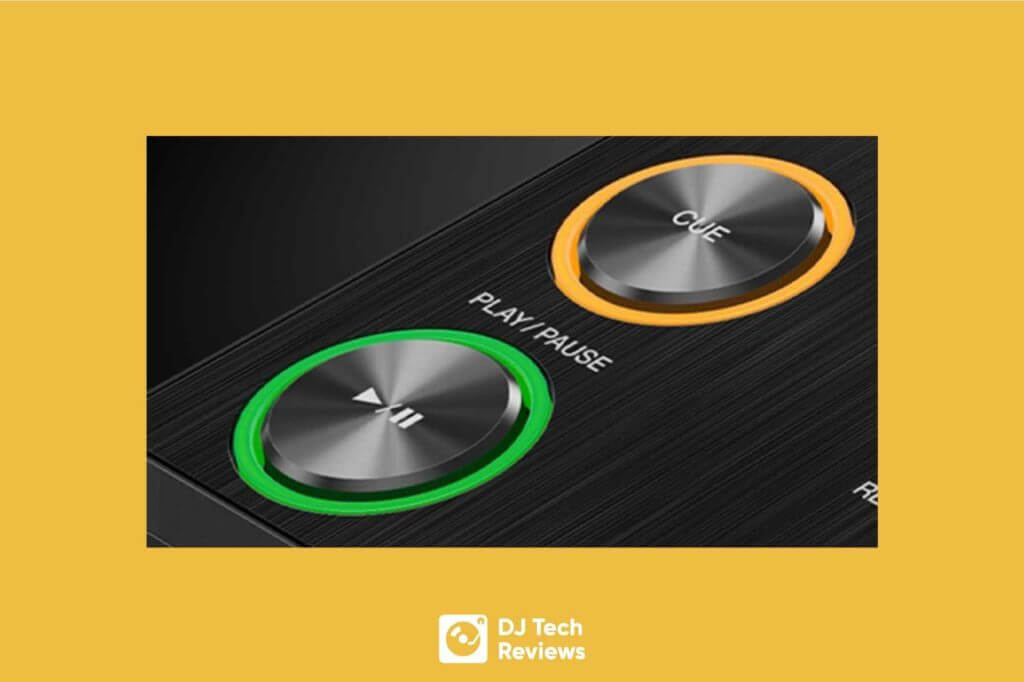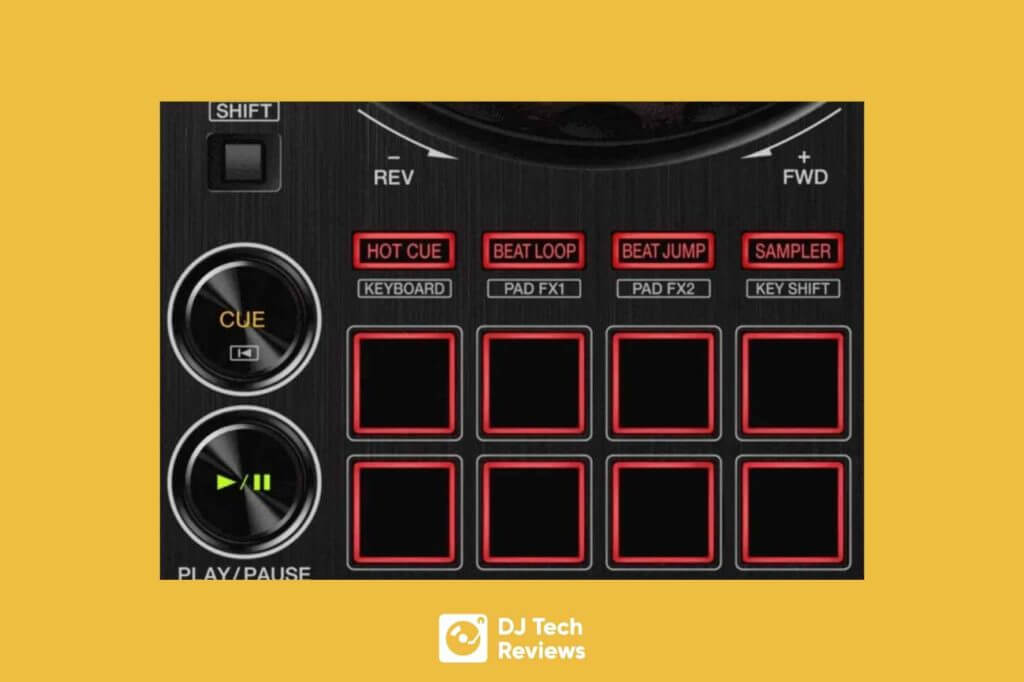When starting as a DJ, there are a LOT of things you need to learn about. From picking the music genres you want to mix to whether you should be using a DJ controller or CDJ.
It can be more than a bit overwhelming to think about all the things you need to know before you can perform a set – especially when the cue button vs the hot cue ‘type’ conversations starts to raise their heads.
After you’ve learned the essential aspects of being a DJ, then there are the supplementary points that, while not vital to your performing at a gig, can turn your current DJ set from good (or less than good) to great or awesome.
One of these key features is none other than understanding the “cue button” as well as deciphering how to use “Hot Cues”.
What Does The Cue Button Do on Mixer? (in short)
Find a part of a track you want to play from. Then pause it. Where the track is paused is now your cue point. Now hit the cue button. This point is now saved. Now every time you hit the cue button on the mixer the track will automatically jump back to that exact point in the track.

Read this next: CDJs vs DJ Controllers (Which Tech is Best?)
What Are Cue Points?
Cue points are specific points situated on a track that, when triggered, would immediately go to the first beat or any specific point available.
These points were first used during the early years of DJing when DJs were using turntables and vinyl records. At the time, this process was called “cueing up a record”
In essence, a cue point is the “point” on a song that you deem is the best time to mix (or bring in) that track.
Finding a suitable point on the INCOMING track reduces any excess part of the track that you do not want to be involved in the mix.
This allows the DJ to maintain tempo and energy throughout their DJ set.
History Of “Cueing-up”
Record cueing was originally started by radio DJs.
While original DJs would often have to suffer the several-second wait for the beat to first hit, radio DJs would have only precious moments on the air, and would need to have things playing as quickly as possible, often instantaneously and as soon as they’d finished talking.
Thus, cueing up was born!
Cueing became even more essential for DJs – even off the air – as track mixing blew up and became more commonplace.
Here, cueing worked to get a track lined up with one another so that one could jump from one song to the other without needing to worry about the second track “buffering”.
By cueing, tracks could be set right to their specific point and mixed in without any issues.
For example, a six-minute track that takes over three minutes to get to the crescendo and climax and parts could be cut down drastically, starting, instead of around the two-minute mark and removing the considerable “dead space” from the long intros.
Cueing is a valuable timesaver and without it, Djing, in its present format, would not exist.
How Does The Cue Button Work?
Essentially, the cue button works pretty much the same as old-school record cueing.
From a functionality standpoint, you’re doing the same thing, only now you’re pressing a button instead of presetting the record on the turntable.
The good news is that you’re in pretty good shape if you’ve already learned how to cue a track in on vinyl.
The way the cue button works is that – like record cueing – when you find the point in a track that you want to mix from, you press the cue button to create a cue point. These points will always be set before when you have mixed into a track and are usually going to be when the first beat starts.
Unlike record cueing – which generally only worked once – using the cue button often allows you to set more than one cue point on a track.
This makes the process of jumping to various parts around of a track much easier and more efficient, than vinyl record cueing often forced a DJ to choose whether to jump to the first beat in a track or the part of a track they found most interesting.

Read this next: What is Phrasing in DJing (DJ Phrasing 101)
How To Use The Cue Button
While things may differ somewhat based on the device you’re using (from the type of DJ controller or CDJ you’re using, to the various software options available), the general way things will play out is that you can set a cue point simply by pressing a button on your device. Where that button is positioned may potentially be different (either in a different part of the controller or located on your laptop as a software feature) but generally, it’s just going to be a button that is easily accessible.
Step #1. Finding a Cue Point
To use the cue button, you must first play the track out until you’ve found and decided upon the intended play point, where you will then set a save as the cue point. From there, you’ll then either press a button to pause the music at that spot or hold the track still via the jogwheel.
You will be able to, at that point, adjust exactly where you want to set it using either the jogwheel or by dragging the track along using your DJ software.
Step #2. Setting Cue Points
After you’ve managed to pause the track to the set point you want to be saved, you’ll then need to firmly establish this point as the cue point. To do this, while the track is still paused, press the cue button. This will then officially mark and save the point as a cue point. This point, once saved, can be immediately jumped to no matter what part of the track you’re on at the time.
Step #3. Locating Cue Points
Now that you’ve established your cue point and have it saved, you will be able to instantly jump to this point at any time. If you’re pressing the cue button while the track is playing, it won’t jump to the point, but rather continue playing the track. It’s only once you’ve let go of the button that the cue point will begin playing.
If you wish to continue playing the track, simply press and hold the “play” button before taking your finger off of the cue button. You can also just press the play button instead of pressing the cue button.
What Is Cue Tapping?
Once you’ve set up your cue points, you may think that you’ve seen all there is to the cue button. In reality, you’ve got a few other things you can do with the cueing feature, one of which is “cue tapping.”
Cue tapping works by continuously tapping the cue button to the timing of the beat just before the beat drops. While it may seem a bit excessive at first glance, what you’re doing is ensuring that, when the beat does drop, the cue point and the beat itself are as closely matched as possible.
As a result, they’ll have much less adjusting to do with the jog wheels by the time the track is playing.

The Cue Button vs. The Hot Cue
Now that we’ve explored what record cueing and the standard cue button features are, we can now get into the specific of hot cueing.
Hot cues are a specific feature that gives a DJ the ability to establish cue points immediately and on the fly.
This can be done even while a track is playing out to its audience. Hot cueing can also be set while planning out your upcoming set ahead of time.
Hot cues are different from the more standard set cue points, as you’ll instantly play them from the moment you press the button.
This means you can hit the hot cue button on a particularly engaging part of a track before pressing it again later when you want to give your audience a second round to enjoy.
Setting Hot Cues
This is super important. Like your cue points, hot cues can be set at just about any point in a track. This allows DJs to be flexible and creative when setting them up.
Below are just a few different places one can set their hot cue points.
#1. Drops
One place you can set your hot cues is along with the major points of a big drop. When done by placing numerous cue points along with a big drop in a track, you can dramatically improve your performance mixing and always be aware, and be able to access, the peak parts of your tracks.
#2. Scratch DJs
If you’re someone that is a fan of scratching, hot cues are a great way to jump directly into the starting point of the scratching sounds. By using hot cues, you can set several different points directly around the sound you want while scratching. While each of these methods has a ton of creativity attached to it, this method is one of the most optimal and a great way for scratch DJs to put together some truly phenomenal sounds.
#3. Vocals
You can also place hot cues along the beginning part of the short vocal shots of the track. From there, you’ll be able to constantly move along the front and the back of the track. This is a great way to create a live remix of the song, as well as dropping in a short vocal hit as you’re performing on the fly.
#4. Breaks
Another place you can set your hot cues is on either side of a break in a track. By setting the hot cues around these parts of a break, you can better keep the beat of a track rolling while simultaneously preventing any need for a pause.

Read this next: Serato DJ or RekordBox DJ – Which is best?
Cue Button vs The Hot Cue: Takeaway
To summarise the Cue Button vs The Hot Cue topic.
Whether it’s dealing with record cueing, standard cue points, or hot cues, understanding the importance of cues and how they operate, while not an absolute essential to DJing, is an absolute essential for anyone interested in becoming a quality DJ.
Take your time in learning how these functions work and ensure you mark your tracks with cue points. It will elevate your DJ playing standards, and, to be frank, they just make DJ life that bit easier!




